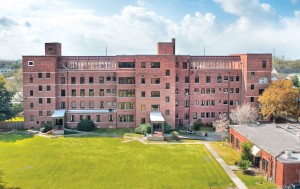City’s rezoning of DePaul hospital site worries neighbors
7th November 2011 · 0 Comments
By Susan Buchanan
Contributing Writer
A proposed zoning change at the old DePaul Hospital—12.5 acres acquired by Children’s Hospital in 2007 – could bring bigger, taller structures, generating more activity at the Calhoun and Camp St. site near Audubon Park, neighbors say. For its part, Children’s Hospital says it has no immediate plans to build there, but will do some renovating.
The expected zoning change is part of a process that began with the city’s adoption last year of its first master plan for long-term development. Current zoning laws, written four decades ago, are over-amended and incoherent, critics say. The New Orleans City Planning Commission has been collecting comments on a draft of its comprehensive zoning ordinance, or CZO, which will decide where development can occur.

Children's Hospital Behavioral Health Building, the old DePaul Hospital, on what is now called the Children's Hospital Calhoun Campus
Under the proposed CZO, the DePaul site’s residential status would change to a “medical campus,” with permitted commercial uses that don’t need special approval. That could pave the way for denser, higher development, neighbors say. The DePaul site would be in the same zoning class as Children’s Hospital, Ochsner Baptist and Touro.
Jay Seastrunk, board member of the Upper Hurstville Residents’Association in the DePaul area, said “our neighborhood organization hopes the site will remain a low-density property in future development. We feel neighborhood input should be required in any new development, as opposed to the owners simply building by right.”
Based on his training as an architect in New Orleans, Seastrunk also has own thoughts about the site. “The potential building envelope at DePaul is huge, numbering millions of square feet. Increased density would place greater demands on the property, not just in terms of traffic and people coming and going, but also on city services and infrastructure—including drainage, street lights and power.” In dense, new developments in New Orleans, needed infrastructure has sometimes been slow to follow. “The city often doesn’t get around to doing it because they’re financially strapped,” he said.
As for land use, Seastrunk noted that Children’s Hospital contains many acres of parking, and could free up space for other purposes by erecting a parking garage.
DePaul neighbors aren’t concerned about anything like the vast destruction of historic houses that’s occurred in lower Mid-City to make way for the LSU-VA Hospital Complex, Seastrunk said.
But “longer term, spot zoning could eventually occur around the DePaul site, turning residences into office buildings—like what’s happened around Touro,” he said. A number of old homes near Touro and Ochsner Baptist are now medical offices or used commercially.
As for DePaul’s status to date, Yolanda Rodriguez, executive director of the City Planning Commission, said “current zoning of the site is RD-2, or two-family residential district. That zoning designation has been in place since 1970.”
Meanwhile, the proposed medical campus designation is under review. At Children’s Hospital, Brian T. Landry, vice president of marketing, said “the City Planning Commission has extended the public comment period on previously submitted Master Plan amendments until December 1. Children’s Hospital is getting ready to submit comments by the due date, and will wait for the planning commission’s recommendations.”
Rodriguez said public comments received on the draft CZO and Master Plan Amendments will be reviewed by city planning staff, zoning consultants and the city’s Zoning Technical Advisory Committee. “A second CZO draft will be released in March 2012 for another round of public comments,” she said. “No deadline has been set for completing review of the current draft.”
Children’s Hospital bought the DePaul property in March 2007 from the Daughters of Charity of St. Vincent de Paul for an undisclosed sum. “We purchased the site to insure our ability to expand over the next 20 to 30 years,” Landry said. “But after acquiring it, we recognized the dearth of mental health services in the area.” At the Calhoun Campus, as the DePaul site is now called, Children’s Hospital operates inpatient adolescent and child psychiatric units, a Parenting Center, a child-at-risk evaluation center and various offices, and leases a building to the Louisiana State University Health Science Center. Landry said Children’s Hospital plans to renovate a few of the buildings on the Calhoun Campus.
In recent years, Children’s Hospital wanted to lease property at Audubon Park. When asked about that, Landry said “there’s a 5.5-acre lot between the hospital and the park that is zoned “MS” or Medical Service, and is owned by the Audubon Commission. The hospital did have discussions with the Audubon Commission about leasing this land.”
That site, which contains Audubon tennis courts and the Avenger Field—a former city playground—wasn’t part of the original Audubon Park. The parcel was purchased from a railroad company more than 60 years ago by a group called Audubon Natatorium. In 1950, the same group sold land to a group of doctors, and the hospital—then called Crippled Children’s, mainly for polio cases—opened as a rehabilitation center in 1955.
Fast forward to the start of this decade, and Children’s Hospital hoped to put buildings and a parking lot on the 5.5-acre “MS” site.
Last week, Sara Meadows Tolleson, president of the Audubon Riverside Neighborhood Association or ARNA, said “as far as I’m aware, opposition last year was so great to the hospital building in park area, and after local politicians let them know about it, the hospital gave up on the idea.”
As for DePaul, Seastrunk said any development there raises broader questions. He said maybe New Orleans hospitals should be built on vacant, blighted urban parcels, some of which are located next to interstate highways. Alternatively, he said new medical facilities could be consolidated in one area of town as Houston and several other U.S. and foreign cities have done.
This article was originally published in the November 7, 2011 print edition of The Louisiana Weekly newspaper



